Key Aspects of Operation Management
VerifiedAdded on 2020/10/22
|18
|5957
|126
AI Summary
This assignment focuses on the key aspects of operation management, covering a range of topics such as sustainability, corporate social responsibility (CSR), and microgrids. It also delves into the importance of ITIL Service Operation, energetic and economic investigations, and RFID-based inventory management frameworks for emergency relief operations. The summary highlights the significance of system dynamics perspectives and modeling opportunities in research related to operation management.
Contribute Materials
Your contribution can guide someone’s learning journey. Share your
documents today.

Management &
Operations
Operations
Secure Best Marks with AI Grader
Need help grading? Try our AI Grader for instant feedback on your assignments.
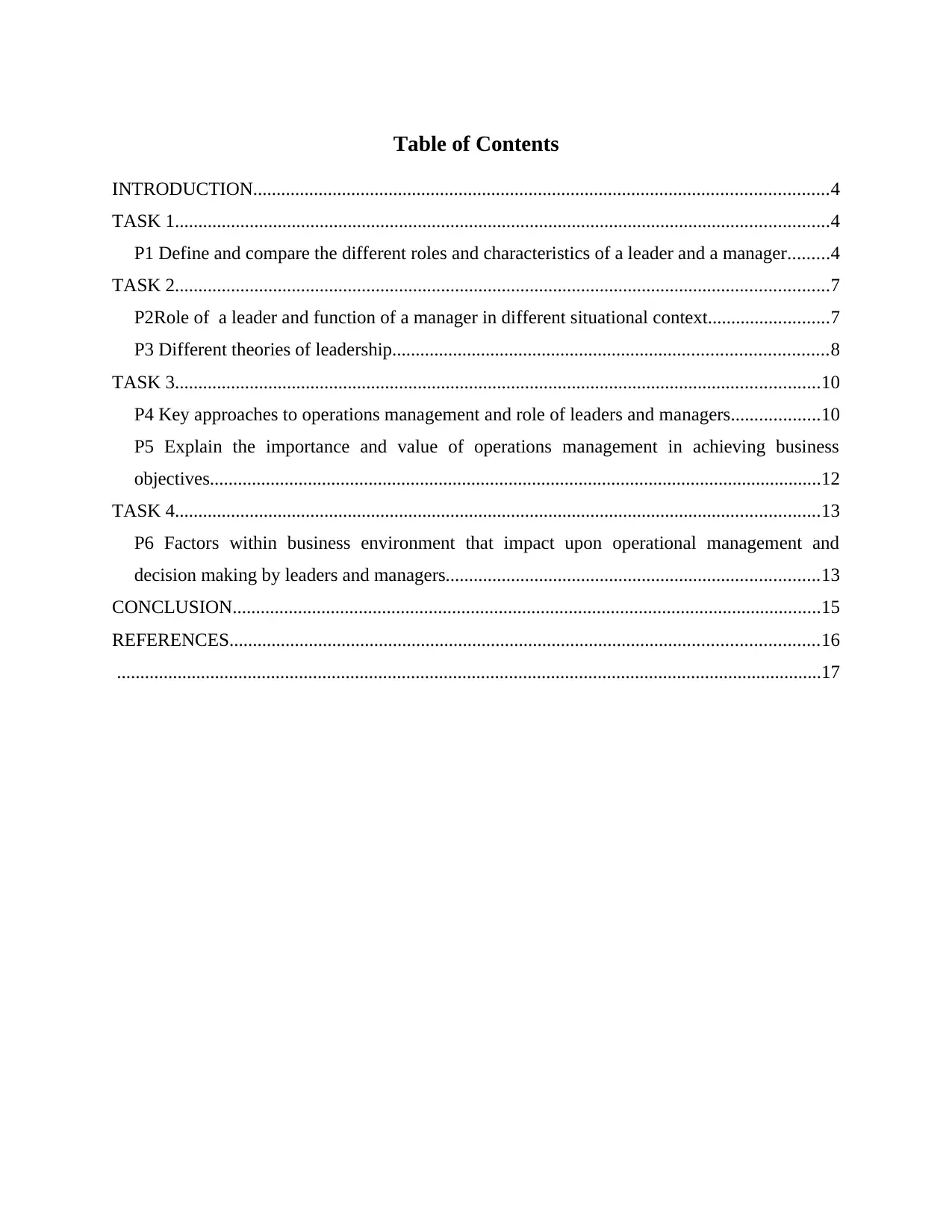
Table of Contents
INTRODUCTION...........................................................................................................................4
TASK 1............................................................................................................................................4
P1 Define and compare the different roles and characteristics of a leader and a manager.........4
TASK 2............................................................................................................................................7
P2Role of a leader and function of a manager in different situational context..........................7
P3 Different theories of leadership.............................................................................................8
TASK 3..........................................................................................................................................10
P4 Key approaches to operations management and role of leaders and managers...................10
P5 Explain the importance and value of operations management in achieving business
objectives...................................................................................................................................12
TASK 4..........................................................................................................................................13
P6 Factors within business environment that impact upon operational management and
decision making by leaders and managers................................................................................13
CONCLUSION..............................................................................................................................15
REFERENCES..............................................................................................................................16
.......................................................................................................................................................17
INTRODUCTION...........................................................................................................................4
TASK 1............................................................................................................................................4
P1 Define and compare the different roles and characteristics of a leader and a manager.........4
TASK 2............................................................................................................................................7
P2Role of a leader and function of a manager in different situational context..........................7
P3 Different theories of leadership.............................................................................................8
TASK 3..........................................................................................................................................10
P4 Key approaches to operations management and role of leaders and managers...................10
P5 Explain the importance and value of operations management in achieving business
objectives...................................................................................................................................12
TASK 4..........................................................................................................................................13
P6 Factors within business environment that impact upon operational management and
decision making by leaders and managers................................................................................13
CONCLUSION..............................................................................................................................15
REFERENCES..............................................................................................................................16
.......................................................................................................................................................17
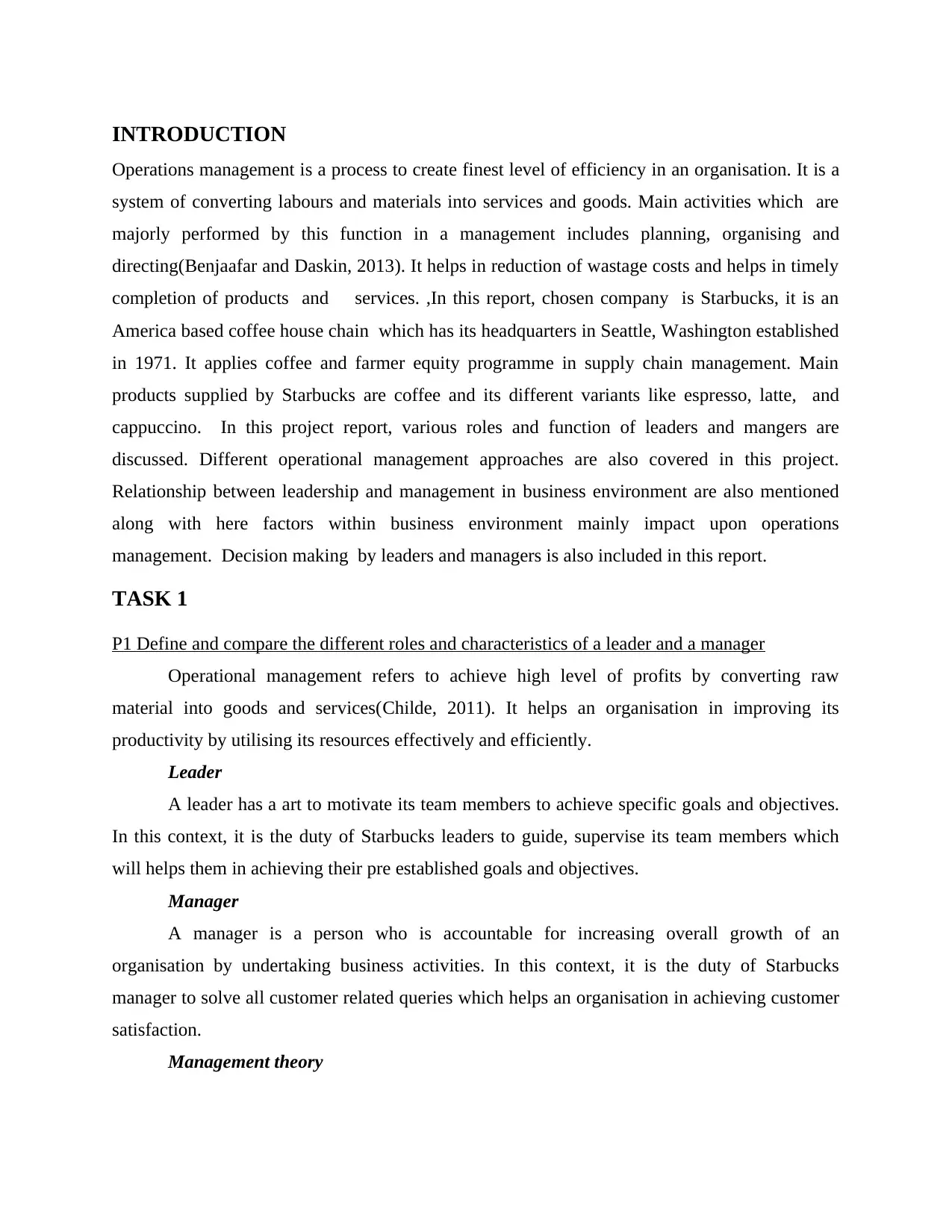
INTRODUCTION
Operations management is a process to create finest level of efficiency in an organisation. It is a
system of converting labours and materials into services and goods. Main activities which are
majorly performed by this function in a management includes planning, organising and
directing(Benjaafar and Daskin, 2013). It helps in reduction of wastage costs and helps in timely
completion of products and services. ,In this report, chosen company is Starbucks, it is an
America based coffee house chain which has its headquarters in Seattle, Washington established
in 1971. It applies coffee and farmer equity programme in supply chain management. Main
products supplied by Starbucks are coffee and its different variants like espresso, latte, and
cappuccino. In this project report, various roles and function of leaders and mangers are
discussed. Different operational management approaches are also covered in this project.
Relationship between leadership and management in business environment are also mentioned
along with here factors within business environment mainly impact upon operations
management. Decision making by leaders and managers is also included in this report.
TASK 1
P1 Define and compare the different roles and characteristics of a leader and a manager
Operational management refers to achieve high level of profits by converting raw
material into goods and services(Childe, 2011). It helps an organisation in improving its
productivity by utilising its resources effectively and efficiently.
Leader
A leader has a art to motivate its team members to achieve specific goals and objectives.
In this context, it is the duty of Starbucks leaders to guide, supervise its team members which
will helps them in achieving their pre established goals and objectives.
Manager
A manager is a person who is accountable for increasing overall growth of an
organisation by undertaking business activities. In this context, it is the duty of Starbucks
manager to solve all customer related queries which helps an organisation in achieving customer
satisfaction.
Management theory
Operations management is a process to create finest level of efficiency in an organisation. It is a
system of converting labours and materials into services and goods. Main activities which are
majorly performed by this function in a management includes planning, organising and
directing(Benjaafar and Daskin, 2013). It helps in reduction of wastage costs and helps in timely
completion of products and services. ,In this report, chosen company is Starbucks, it is an
America based coffee house chain which has its headquarters in Seattle, Washington established
in 1971. It applies coffee and farmer equity programme in supply chain management. Main
products supplied by Starbucks are coffee and its different variants like espresso, latte, and
cappuccino. In this project report, various roles and function of leaders and mangers are
discussed. Different operational management approaches are also covered in this project.
Relationship between leadership and management in business environment are also mentioned
along with here factors within business environment mainly impact upon operations
management. Decision making by leaders and managers is also included in this report.
TASK 1
P1 Define and compare the different roles and characteristics of a leader and a manager
Operational management refers to achieve high level of profits by converting raw
material into goods and services(Childe, 2011). It helps an organisation in improving its
productivity by utilising its resources effectively and efficiently.
Leader
A leader has a art to motivate its team members to achieve specific goals and objectives.
In this context, it is the duty of Starbucks leaders to guide, supervise its team members which
will helps them in achieving their pre established goals and objectives.
Manager
A manager is a person who is accountable for increasing overall growth of an
organisation by undertaking business activities. In this context, it is the duty of Starbucks
manager to solve all customer related queries which helps an organisation in achieving customer
satisfaction.
Management theory
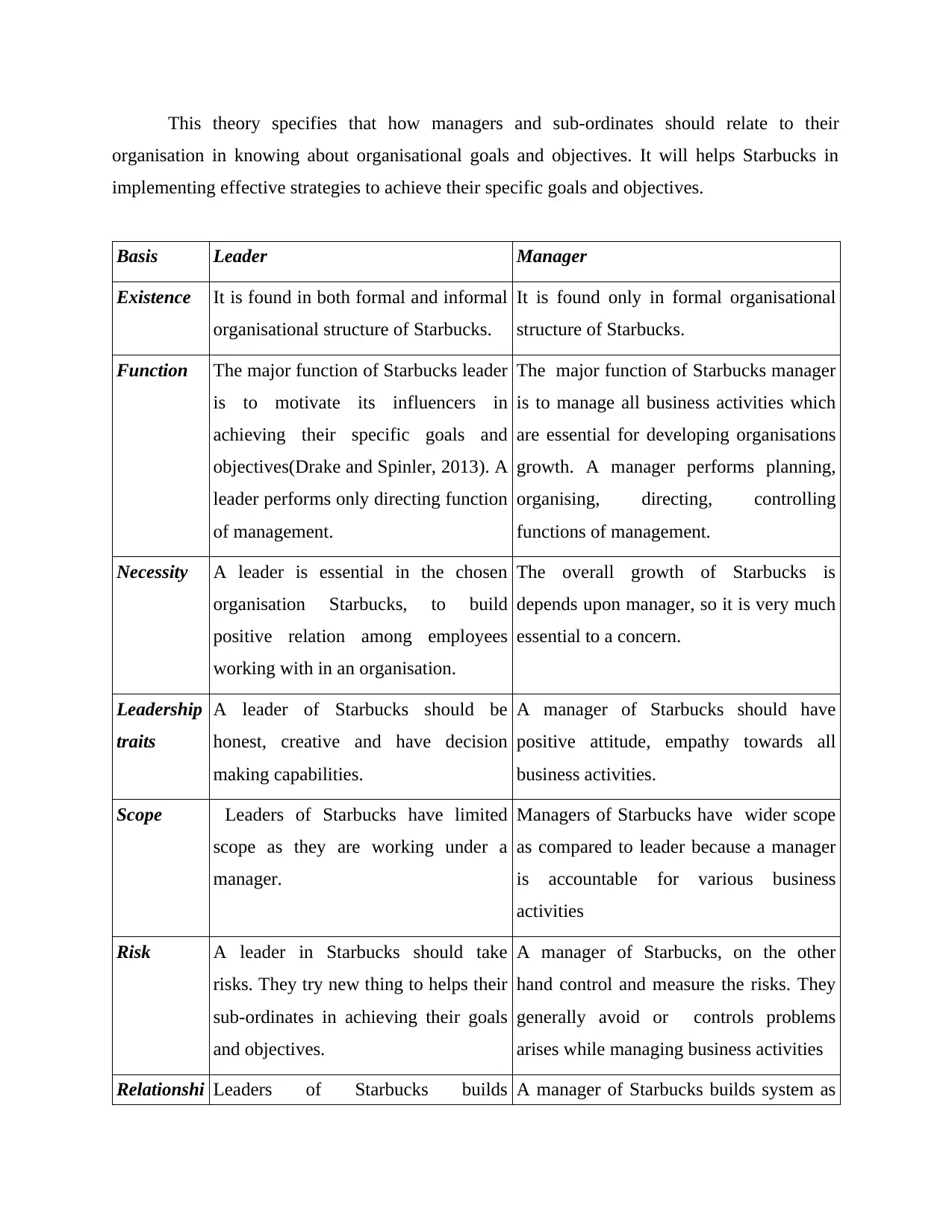
This theory specifies that how managers and sub-ordinates should relate to their
organisation in knowing about organisational goals and objectives. It will helps Starbucks in
implementing effective strategies to achieve their specific goals and objectives.
Basis Leader Manager
Existence It is found in both formal and informal
organisational structure of Starbucks.
It is found only in formal organisational
structure of Starbucks.
Function The major function of Starbucks leader
is to motivate its influencers in
achieving their specific goals and
objectives(Drake and Spinler, 2013). A
leader performs only directing function
of management.
The major function of Starbucks manager
is to manage all business activities which
are essential for developing organisations
growth. A manager performs planning,
organising, directing, controlling
functions of management.
Necessity A leader is essential in the chosen
organisation Starbucks, to build
positive relation among employees
working with in an organisation.
The overall growth of Starbucks is
depends upon manager, so it is very much
essential to a concern.
Leadership
traits
A leader of Starbucks should be
honest, creative and have decision
making capabilities.
A manager of Starbucks should have
positive attitude, empathy towards all
business activities.
Scope Leaders of Starbucks have limited
scope as they are working under a
manager.
Managers of Starbucks have wider scope
as compared to leader because a manager
is accountable for various business
activities
Risk A leader in Starbucks should take
risks. They try new thing to helps their
sub-ordinates in achieving their goals
and objectives.
A manager of Starbucks, on the other
hand control and measure the risks. They
generally avoid or controls problems
arises while managing business activities
Relationshi Leaders of Starbucks builds A manager of Starbucks builds system as
organisation in knowing about organisational goals and objectives. It will helps Starbucks in
implementing effective strategies to achieve their specific goals and objectives.
Basis Leader Manager
Existence It is found in both formal and informal
organisational structure of Starbucks.
It is found only in formal organisational
structure of Starbucks.
Function The major function of Starbucks leader
is to motivate its influencers in
achieving their specific goals and
objectives(Drake and Spinler, 2013). A
leader performs only directing function
of management.
The major function of Starbucks manager
is to manage all business activities which
are essential for developing organisations
growth. A manager performs planning,
organising, directing, controlling
functions of management.
Necessity A leader is essential in the chosen
organisation Starbucks, to build
positive relation among employees
working with in an organisation.
The overall growth of Starbucks is
depends upon manager, so it is very much
essential to a concern.
Leadership
traits
A leader of Starbucks should be
honest, creative and have decision
making capabilities.
A manager of Starbucks should have
positive attitude, empathy towards all
business activities.
Scope Leaders of Starbucks have limited
scope as they are working under a
manager.
Managers of Starbucks have wider scope
as compared to leader because a manager
is accountable for various business
activities
Risk A leader in Starbucks should take
risks. They try new thing to helps their
sub-ordinates in achieving their goals
and objectives.
A manager of Starbucks, on the other
hand control and measure the risks. They
generally avoid or controls problems
arises while managing business activities
Relationshi Leaders of Starbucks builds A manager of Starbucks builds system as
Secure Best Marks with AI Grader
Need help grading? Try our AI Grader for instant feedback on your assignments.

p relationship as its their duty to
motivate their influencers toward
achieving their goals which leads in
spending more time with their peoples.
they focus on outcomes arises from
business activities. They works with
individual and their goals and objectives.
Management functions:
(a) Planning:
It is the important management function which is future oriented and determines an
organisations direction(Griffin 2013). This function of management will helps Starbucks in
developing a portfolio about organisation future activities which leads them in gaining
competitive advantage and increasing its productivity.
(b) Organising:
It is a function in which it is essential for an organisation to determine various activities
that should be done in order to achieve organisational goals and objectives(Ham, Hitomi and
Yoshida, 2012). In this function, Starbucks has to collect required resources like raw material,
labour and finance which helps them in increasing their productivity in a business environment.
(c) Staffing
It is the function of management which involves, recruiting, developing, training and
evaluating employees. In this context, it is essential for Starbucks to motivate its employees
which will helps them in maintaining its workforce efficiently.
(d) Directing
In this function involves supervising, guiding employees of an organisation in order to
motivate them to achieve their goals and objectives. In this context, it will helps Starbucks in
making their workforce productive in a dynamic business environment.
(e) Controlling:
In this function involves activities that should be undertaken to make sure that business
activities are going as per the pre arranged plans(Hoi and Zhang, 2013). In this context, it will
helps Starbucks in measuring and comparing performance of its employees according to the set
standards.
Transformational and transactional leadership
motivate their influencers toward
achieving their goals which leads in
spending more time with their peoples.
they focus on outcomes arises from
business activities. They works with
individual and their goals and objectives.
Management functions:
(a) Planning:
It is the important management function which is future oriented and determines an
organisations direction(Griffin 2013). This function of management will helps Starbucks in
developing a portfolio about organisation future activities which leads them in gaining
competitive advantage and increasing its productivity.
(b) Organising:
It is a function in which it is essential for an organisation to determine various activities
that should be done in order to achieve organisational goals and objectives(Ham, Hitomi and
Yoshida, 2012). In this function, Starbucks has to collect required resources like raw material,
labour and finance which helps them in increasing their productivity in a business environment.
(c) Staffing
It is the function of management which involves, recruiting, developing, training and
evaluating employees. In this context, it is essential for Starbucks to motivate its employees
which will helps them in maintaining its workforce efficiently.
(d) Directing
In this function involves supervising, guiding employees of an organisation in order to
motivate them to achieve their goals and objectives. In this context, it will helps Starbucks in
making their workforce productive in a dynamic business environment.
(e) Controlling:
In this function involves activities that should be undertaken to make sure that business
activities are going as per the pre arranged plans(Hoi and Zhang, 2013). In this context, it will
helps Starbucks in measuring and comparing performance of its employees according to the set
standards.
Transformational and transactional leadership
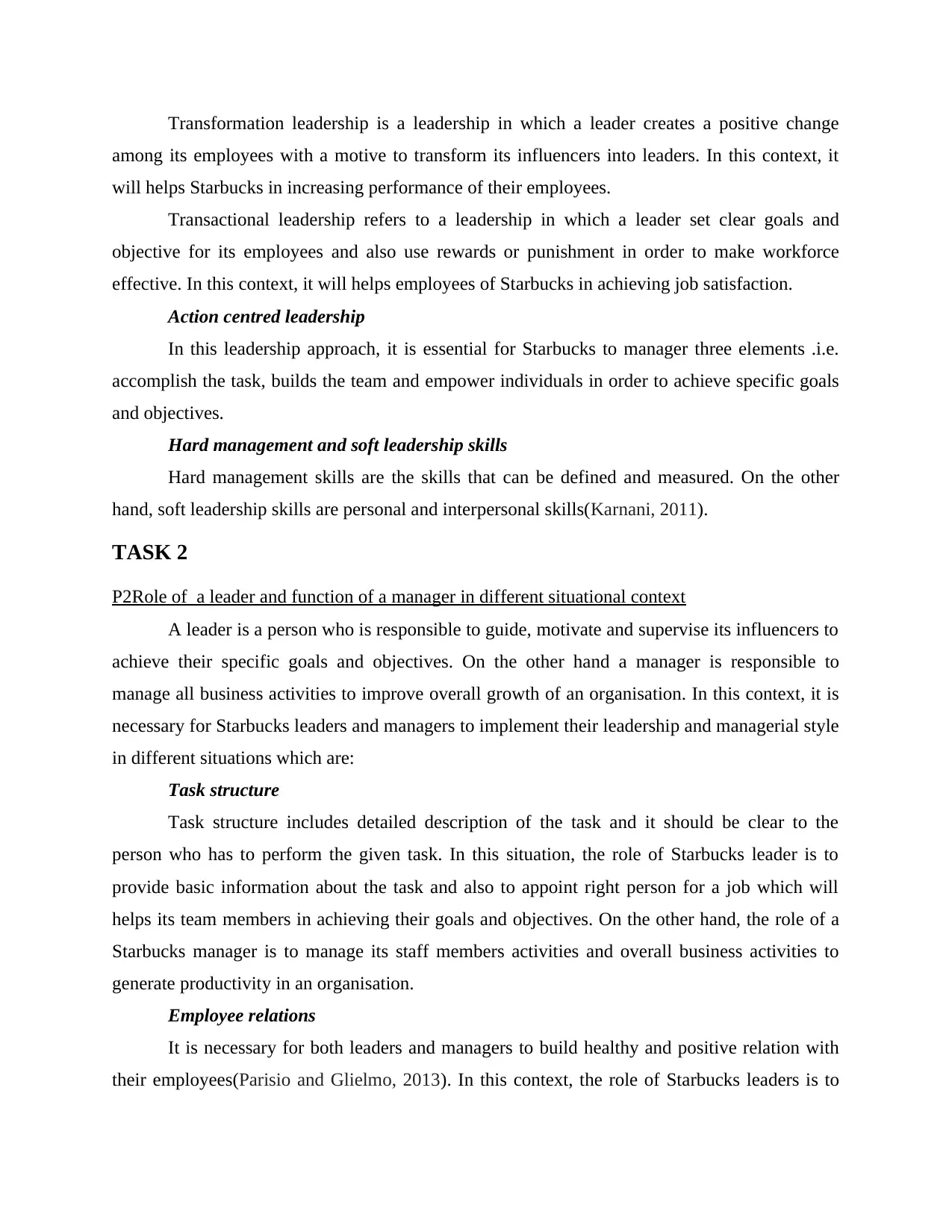
Transformation leadership is a leadership in which a leader creates a positive change
among its employees with a motive to transform its influencers into leaders. In this context, it
will helps Starbucks in increasing performance of their employees.
Transactional leadership refers to a leadership in which a leader set clear goals and
objective for its employees and also use rewards or punishment in order to make workforce
effective. In this context, it will helps employees of Starbucks in achieving job satisfaction.
Action centred leadership
In this leadership approach, it is essential for Starbucks to manager three elements .i.e.
accomplish the task, builds the team and empower individuals in order to achieve specific goals
and objectives.
Hard management and soft leadership skills
Hard management skills are the skills that can be defined and measured. On the other
hand, soft leadership skills are personal and interpersonal skills(Karnani, 2011).
TASK 2
P2Role of a leader and function of a manager in different situational context
A leader is a person who is responsible to guide, motivate and supervise its influencers to
achieve their specific goals and objectives. On the other hand a manager is responsible to
manage all business activities to improve overall growth of an organisation. In this context, it is
necessary for Starbucks leaders and managers to implement their leadership and managerial style
in different situations which are:
Task structure
Task structure includes detailed description of the task and it should be clear to the
person who has to perform the given task. In this situation, the role of Starbucks leader is to
provide basic information about the task and also to appoint right person for a job which will
helps its team members in achieving their goals and objectives. On the other hand, the role of a
Starbucks manager is to manage its staff members activities and overall business activities to
generate productivity in an organisation.
Employee relations
It is necessary for both leaders and managers to build healthy and positive relation with
their employees(Parisio and Glielmo, 2013). In this context, the role of Starbucks leaders is to
among its employees with a motive to transform its influencers into leaders. In this context, it
will helps Starbucks in increasing performance of their employees.
Transactional leadership refers to a leadership in which a leader set clear goals and
objective for its employees and also use rewards or punishment in order to make workforce
effective. In this context, it will helps employees of Starbucks in achieving job satisfaction.
Action centred leadership
In this leadership approach, it is essential for Starbucks to manager three elements .i.e.
accomplish the task, builds the team and empower individuals in order to achieve specific goals
and objectives.
Hard management and soft leadership skills
Hard management skills are the skills that can be defined and measured. On the other
hand, soft leadership skills are personal and interpersonal skills(Karnani, 2011).
TASK 2
P2Role of a leader and function of a manager in different situational context
A leader is a person who is responsible to guide, motivate and supervise its influencers to
achieve their specific goals and objectives. On the other hand a manager is responsible to
manage all business activities to improve overall growth of an organisation. In this context, it is
necessary for Starbucks leaders and managers to implement their leadership and managerial style
in different situations which are:
Task structure
Task structure includes detailed description of the task and it should be clear to the
person who has to perform the given task. In this situation, the role of Starbucks leader is to
provide basic information about the task and also to appoint right person for a job which will
helps its team members in achieving their goals and objectives. On the other hand, the role of a
Starbucks manager is to manage its staff members activities and overall business activities to
generate productivity in an organisation.
Employee relations
It is necessary for both leaders and managers to build healthy and positive relation with
their employees(Parisio and Glielmo, 2013). In this context, the role of Starbucks leaders is to
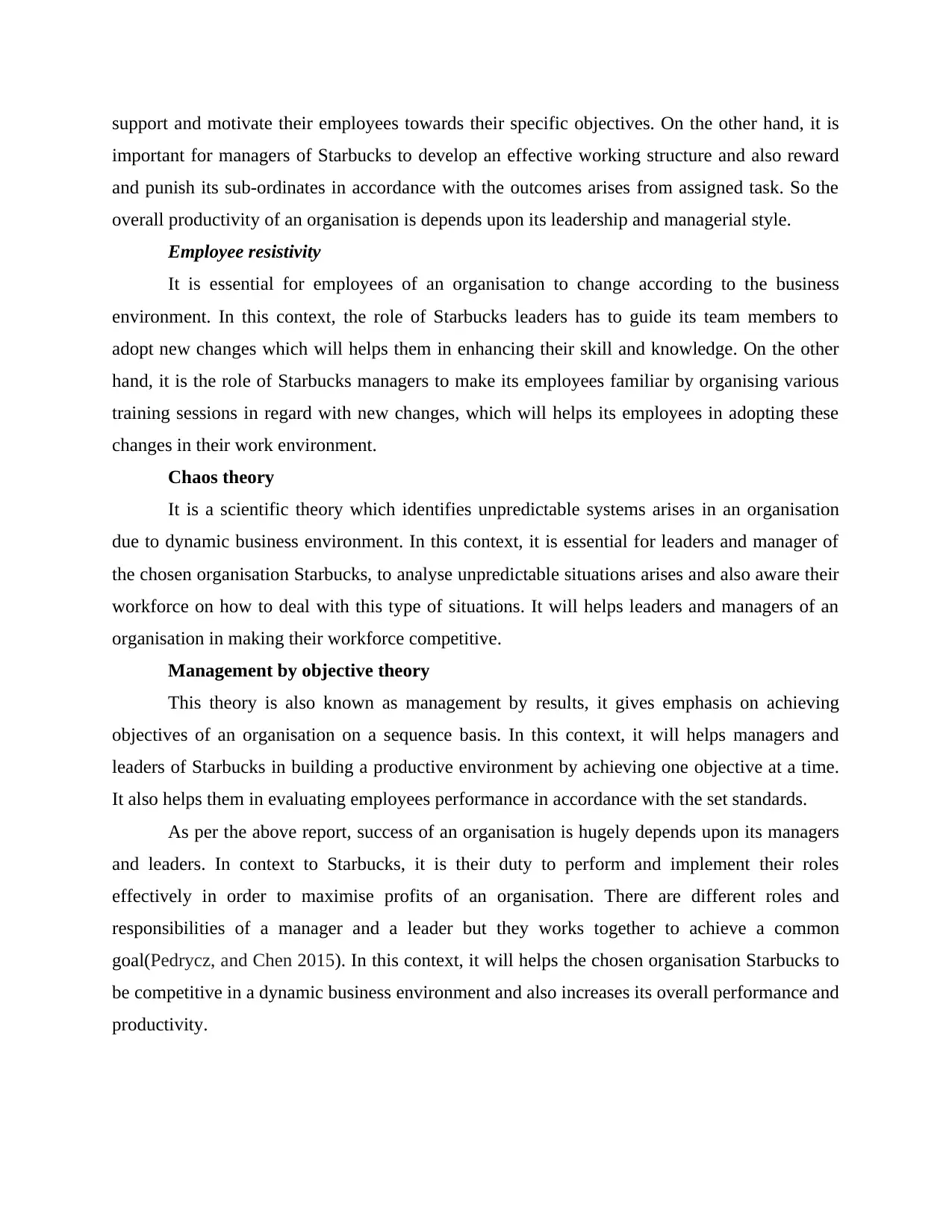
support and motivate their employees towards their specific objectives. On the other hand, it is
important for managers of Starbucks to develop an effective working structure and also reward
and punish its sub-ordinates in accordance with the outcomes arises from assigned task. So the
overall productivity of an organisation is depends upon its leadership and managerial style.
Employee resistivity
It is essential for employees of an organisation to change according to the business
environment. In this context, the role of Starbucks leaders has to guide its team members to
adopt new changes which will helps them in enhancing their skill and knowledge. On the other
hand, it is the role of Starbucks managers to make its employees familiar by organising various
training sessions in regard with new changes, which will helps its employees in adopting these
changes in their work environment.
Chaos theory
It is a scientific theory which identifies unpredictable systems arises in an organisation
due to dynamic business environment. In this context, it is essential for leaders and manager of
the chosen organisation Starbucks, to analyse unpredictable situations arises and also aware their
workforce on how to deal with this type of situations. It will helps leaders and managers of an
organisation in making their workforce competitive.
Management by objective theory
This theory is also known as management by results, it gives emphasis on achieving
objectives of an organisation on a sequence basis. In this context, it will helps managers and
leaders of Starbucks in building a productive environment by achieving one objective at a time.
It also helps them in evaluating employees performance in accordance with the set standards.
As per the above report, success of an organisation is hugely depends upon its managers
and leaders. In context to Starbucks, it is their duty to perform and implement their roles
effectively in order to maximise profits of an organisation. There are different roles and
responsibilities of a manager and a leader but they works together to achieve a common
goal(Pedrycz, and Chen 2015). In this context, it will helps the chosen organisation Starbucks to
be competitive in a dynamic business environment and also increases its overall performance and
productivity.
important for managers of Starbucks to develop an effective working structure and also reward
and punish its sub-ordinates in accordance with the outcomes arises from assigned task. So the
overall productivity of an organisation is depends upon its leadership and managerial style.
Employee resistivity
It is essential for employees of an organisation to change according to the business
environment. In this context, the role of Starbucks leaders has to guide its team members to
adopt new changes which will helps them in enhancing their skill and knowledge. On the other
hand, it is the role of Starbucks managers to make its employees familiar by organising various
training sessions in regard with new changes, which will helps its employees in adopting these
changes in their work environment.
Chaos theory
It is a scientific theory which identifies unpredictable systems arises in an organisation
due to dynamic business environment. In this context, it is essential for leaders and manager of
the chosen organisation Starbucks, to analyse unpredictable situations arises and also aware their
workforce on how to deal with this type of situations. It will helps leaders and managers of an
organisation in making their workforce competitive.
Management by objective theory
This theory is also known as management by results, it gives emphasis on achieving
objectives of an organisation on a sequence basis. In this context, it will helps managers and
leaders of Starbucks in building a productive environment by achieving one objective at a time.
It also helps them in evaluating employees performance in accordance with the set standards.
As per the above report, success of an organisation is hugely depends upon its managers
and leaders. In context to Starbucks, it is their duty to perform and implement their roles
effectively in order to maximise profits of an organisation. There are different roles and
responsibilities of a manager and a leader but they works together to achieve a common
goal(Pedrycz, and Chen 2015). In this context, it will helps the chosen organisation Starbucks to
be competitive in a dynamic business environment and also increases its overall performance and
productivity.
Paraphrase This Document
Need a fresh take? Get an instant paraphrase of this document with our AI Paraphraser
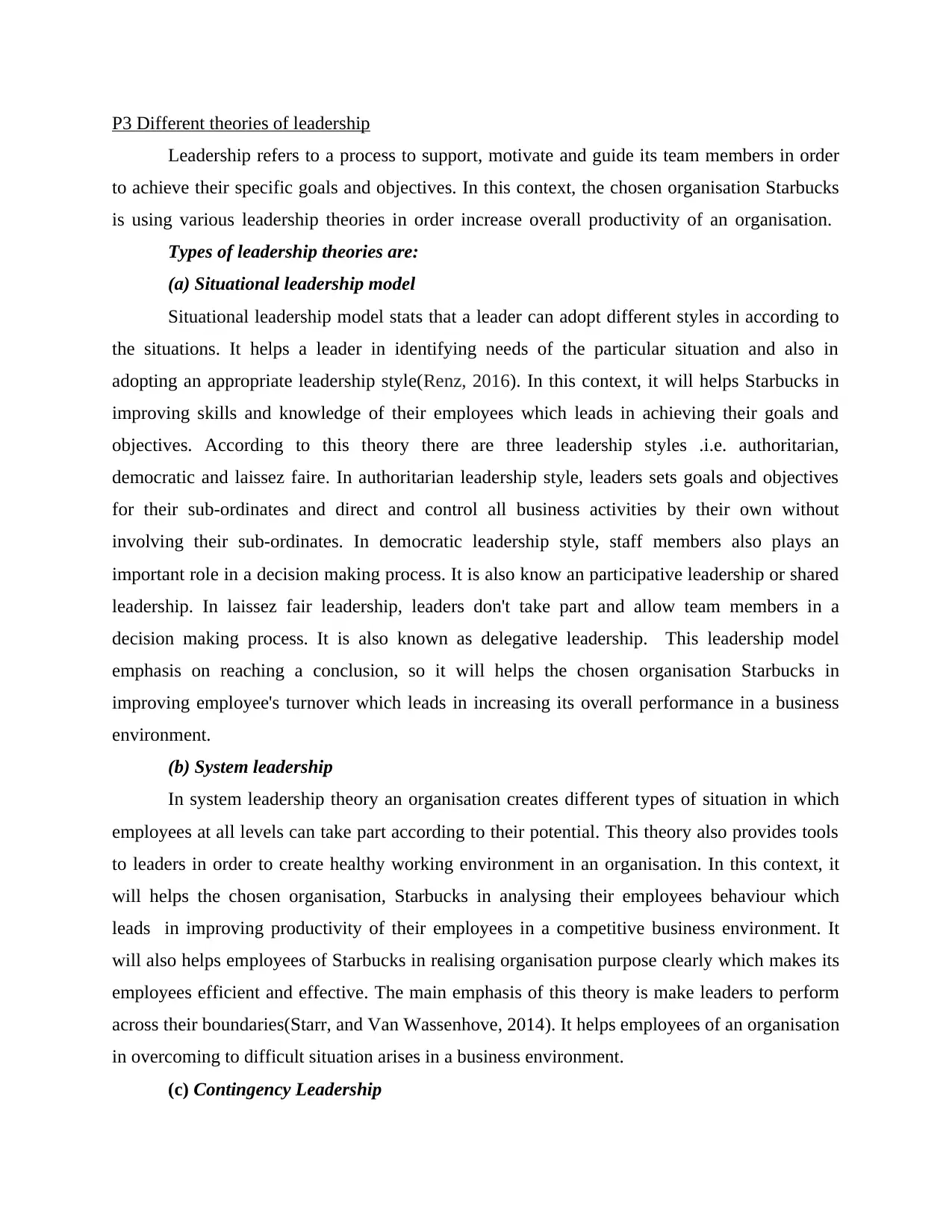
P3 Different theories of leadership
Leadership refers to a process to support, motivate and guide its team members in order
to achieve their specific goals and objectives. In this context, the chosen organisation Starbucks
is using various leadership theories in order increase overall productivity of an organisation.
Types of leadership theories are:
(a) Situational leadership model
Situational leadership model stats that a leader can adopt different styles in according to
the situations. It helps a leader in identifying needs of the particular situation and also in
adopting an appropriate leadership style(Renz, 2016). In this context, it will helps Starbucks in
improving skills and knowledge of their employees which leads in achieving their goals and
objectives. According to this theory there are three leadership styles .i.e. authoritarian,
democratic and laissez faire. In authoritarian leadership style, leaders sets goals and objectives
for their sub-ordinates and direct and control all business activities by their own without
involving their sub-ordinates. In democratic leadership style, staff members also plays an
important role in a decision making process. It is also know an participative leadership or shared
leadership. In laissez fair leadership, leaders don't take part and allow team members in a
decision making process. It is also known as delegative leadership. This leadership model
emphasis on reaching a conclusion, so it will helps the chosen organisation Starbucks in
improving employee's turnover which leads in increasing its overall performance in a business
environment.
(b) System leadership
In system leadership theory an organisation creates different types of situation in which
employees at all levels can take part according to their potential. This theory also provides tools
to leaders in order to create healthy working environment in an organisation. In this context, it
will helps the chosen organisation, Starbucks in analysing their employees behaviour which
leads in improving productivity of their employees in a competitive business environment. It
will also helps employees of Starbucks in realising organisation purpose clearly which makes its
employees efficient and effective. The main emphasis of this theory is make leaders to perform
across their boundaries(Starr, and Van Wassenhove, 2014). It helps employees of an organisation
in overcoming to difficult situation arises in a business environment.
(c) Contingency Leadership
Leadership refers to a process to support, motivate and guide its team members in order
to achieve their specific goals and objectives. In this context, the chosen organisation Starbucks
is using various leadership theories in order increase overall productivity of an organisation.
Types of leadership theories are:
(a) Situational leadership model
Situational leadership model stats that a leader can adopt different styles in according to
the situations. It helps a leader in identifying needs of the particular situation and also in
adopting an appropriate leadership style(Renz, 2016). In this context, it will helps Starbucks in
improving skills and knowledge of their employees which leads in achieving their goals and
objectives. According to this theory there are three leadership styles .i.e. authoritarian,
democratic and laissez faire. In authoritarian leadership style, leaders sets goals and objectives
for their sub-ordinates and direct and control all business activities by their own without
involving their sub-ordinates. In democratic leadership style, staff members also plays an
important role in a decision making process. It is also know an participative leadership or shared
leadership. In laissez fair leadership, leaders don't take part and allow team members in a
decision making process. It is also known as delegative leadership. This leadership model
emphasis on reaching a conclusion, so it will helps the chosen organisation Starbucks in
improving employee's turnover which leads in increasing its overall performance in a business
environment.
(b) System leadership
In system leadership theory an organisation creates different types of situation in which
employees at all levels can take part according to their potential. This theory also provides tools
to leaders in order to create healthy working environment in an organisation. In this context, it
will helps the chosen organisation, Starbucks in analysing their employees behaviour which
leads in improving productivity of their employees in a competitive business environment. It
will also helps employees of Starbucks in realising organisation purpose clearly which makes its
employees efficient and effective. The main emphasis of this theory is make leaders to perform
across their boundaries(Starr, and Van Wassenhove, 2014). It helps employees of an organisation
in overcoming to difficult situation arises in a business environment.
(c) Contingency Leadership

This leadership theory stats that an organisations success depends upon its internal and
external factors. It also stats that style of leadership changes in accordance with the business
environment which is dynamic. It will helps an organisation in facing future challenges which
leads in enhancing performance of its workforce. It will also helps managers and leaders of an
organisation in creating a good relation with their subordinates(Steinberg, 2011). The chosen
organisation Starbucks can follow this theory as it helps them in their overall growth by making
their employees efficient and effective. Through this theory, Starbucks can balance their needs
and behaviours according to the business environment. In some situations, this theory is not
suitable for Starbucks because it is time consuming as they have to identify needs and manage
behaviour of their employees according to the needs. In this approach, power lies on the hand of
managers and leaders, so they can punish or reward their employees in according to the task
assigned.
(d) Relationship oriented approach
In this approach, a leader knows the importance of achieving organisational objectives
but also makes an effort in satisfying needs and requirements of its team members. It involves
compensations, spending time with its team members and helps them in solving their issues. In
this context, it will helps Starbucks in achieving productivity but also in creating positive work
environment in an organisation.
As per the above mentioned report, it has been analysed that situational leadership theory
is more productive for Starbucks as it help the organisation to change according to different
situations, which will make an organisation dynamic and also helps in gaining competitive
advantage in business environment. It will also makes workforce of Starbucks efficient as it
enhances skills and knowledge of its employees, which leads in improving productivity of an
organisation for a longer run in a competitive market.
TASK 3
P4 Key approaches to operations management and role of leaders and managers.
Operations management is a vital part of working process of any organisation. It is
majorly concerned with basic functions of management such as planning, organising and also
supervision in terms of production, manufacturing and provision of services. Operations
external factors. It also stats that style of leadership changes in accordance with the business
environment which is dynamic. It will helps an organisation in facing future challenges which
leads in enhancing performance of its workforce. It will also helps managers and leaders of an
organisation in creating a good relation with their subordinates(Steinberg, 2011). The chosen
organisation Starbucks can follow this theory as it helps them in their overall growth by making
their employees efficient and effective. Through this theory, Starbucks can balance their needs
and behaviours according to the business environment. In some situations, this theory is not
suitable for Starbucks because it is time consuming as they have to identify needs and manage
behaviour of their employees according to the needs. In this approach, power lies on the hand of
managers and leaders, so they can punish or reward their employees in according to the task
assigned.
(d) Relationship oriented approach
In this approach, a leader knows the importance of achieving organisational objectives
but also makes an effort in satisfying needs and requirements of its team members. It involves
compensations, spending time with its team members and helps them in solving their issues. In
this context, it will helps Starbucks in achieving productivity but also in creating positive work
environment in an organisation.
As per the above mentioned report, it has been analysed that situational leadership theory
is more productive for Starbucks as it help the organisation to change according to different
situations, which will make an organisation dynamic and also helps in gaining competitive
advantage in business environment. It will also makes workforce of Starbucks efficient as it
enhances skills and knowledge of its employees, which leads in improving productivity of an
organisation for a longer run in a competitive market.
TASK 3
P4 Key approaches to operations management and role of leaders and managers.
Operations management is a vital part of working process of any organisation. It is
majorly concerned with basic functions of management such as planning, organising and also
supervision in terms of production, manufacturing and provision of services. Operations
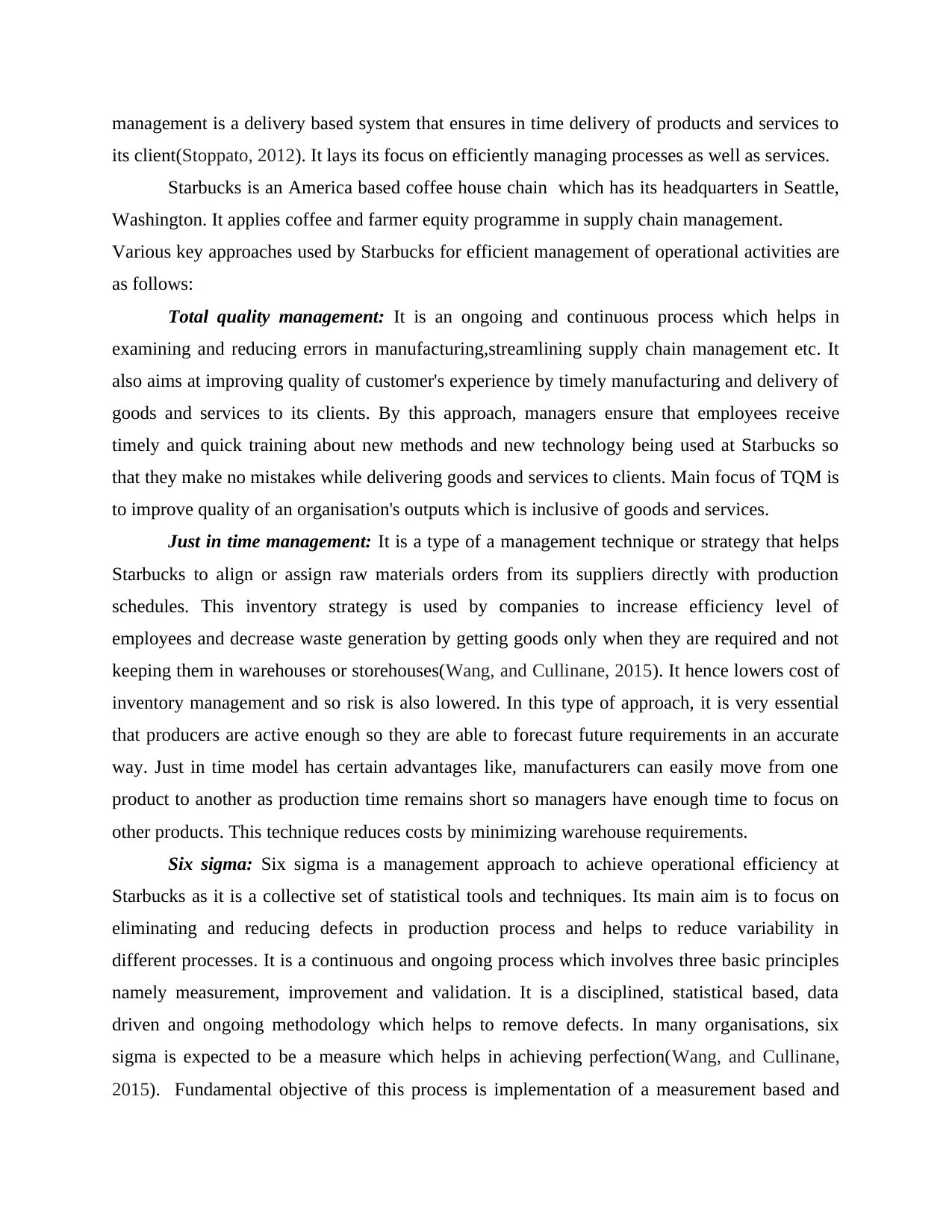
management is a delivery based system that ensures in time delivery of products and services to
its client(Stoppato, 2012). It lays its focus on efficiently managing processes as well as services.
Starbucks is an America based coffee house chain which has its headquarters in Seattle,
Washington. It applies coffee and farmer equity programme in supply chain management.
Various key approaches used by Starbucks for efficient management of operational activities are
as follows:
Total quality management: It is an ongoing and continuous process which helps in
examining and reducing errors in manufacturing,streamlining supply chain management etc. It
also aims at improving quality of customer's experience by timely manufacturing and delivery of
goods and services to its clients. By this approach, managers ensure that employees receive
timely and quick training about new methods and new technology being used at Starbucks so
that they make no mistakes while delivering goods and services to clients. Main focus of TQM is
to improve quality of an organisation's outputs which is inclusive of goods and services.
Just in time management: It is a type of a management technique or strategy that helps
Starbucks to align or assign raw materials orders from its suppliers directly with production
schedules. This inventory strategy is used by companies to increase efficiency level of
employees and decrease waste generation by getting goods only when they are required and not
keeping them in warehouses or storehouses(Wang, and Cullinane, 2015). It hence lowers cost of
inventory management and so risk is also lowered. In this type of approach, it is very essential
that producers are active enough so they are able to forecast future requirements in an accurate
way. Just in time model has certain advantages like, manufacturers can easily move from one
product to another as production time remains short so managers have enough time to focus on
other products. This technique reduces costs by minimizing warehouse requirements.
Six sigma: Six sigma is a management approach to achieve operational efficiency at
Starbucks as it is a collective set of statistical tools and techniques. Its main aim is to focus on
eliminating and reducing defects in production process and helps to reduce variability in
different processes. It is a continuous and ongoing process which involves three basic principles
namely measurement, improvement and validation. It is a disciplined, statistical based, data
driven and ongoing methodology which helps to remove defects. In many organisations, six
sigma is expected to be a measure which helps in achieving perfection(Wang, and Cullinane,
2015). Fundamental objective of this process is implementation of a measurement based and
its client(Stoppato, 2012). It lays its focus on efficiently managing processes as well as services.
Starbucks is an America based coffee house chain which has its headquarters in Seattle,
Washington. It applies coffee and farmer equity programme in supply chain management.
Various key approaches used by Starbucks for efficient management of operational activities are
as follows:
Total quality management: It is an ongoing and continuous process which helps in
examining and reducing errors in manufacturing,streamlining supply chain management etc. It
also aims at improving quality of customer's experience by timely manufacturing and delivery of
goods and services to its clients. By this approach, managers ensure that employees receive
timely and quick training about new methods and new technology being used at Starbucks so
that they make no mistakes while delivering goods and services to clients. Main focus of TQM is
to improve quality of an organisation's outputs which is inclusive of goods and services.
Just in time management: It is a type of a management technique or strategy that helps
Starbucks to align or assign raw materials orders from its suppliers directly with production
schedules. This inventory strategy is used by companies to increase efficiency level of
employees and decrease waste generation by getting goods only when they are required and not
keeping them in warehouses or storehouses(Wang, and Cullinane, 2015). It hence lowers cost of
inventory management and so risk is also lowered. In this type of approach, it is very essential
that producers are active enough so they are able to forecast future requirements in an accurate
way. Just in time model has certain advantages like, manufacturers can easily move from one
product to another as production time remains short so managers have enough time to focus on
other products. This technique reduces costs by minimizing warehouse requirements.
Six sigma: Six sigma is a management approach to achieve operational efficiency at
Starbucks as it is a collective set of statistical tools and techniques. Its main aim is to focus on
eliminating and reducing defects in production process and helps to reduce variability in
different processes. It is a continuous and ongoing process which involves three basic principles
namely measurement, improvement and validation. It is a disciplined, statistical based, data
driven and ongoing methodology which helps to remove defects. In many organisations, six
sigma is expected to be a measure which helps in achieving perfection(Wang, and Cullinane,
2015). Fundamental objective of this process is implementation of a measurement based and
Secure Best Marks with AI Grader
Need help grading? Try our AI Grader for instant feedback on your assignments.
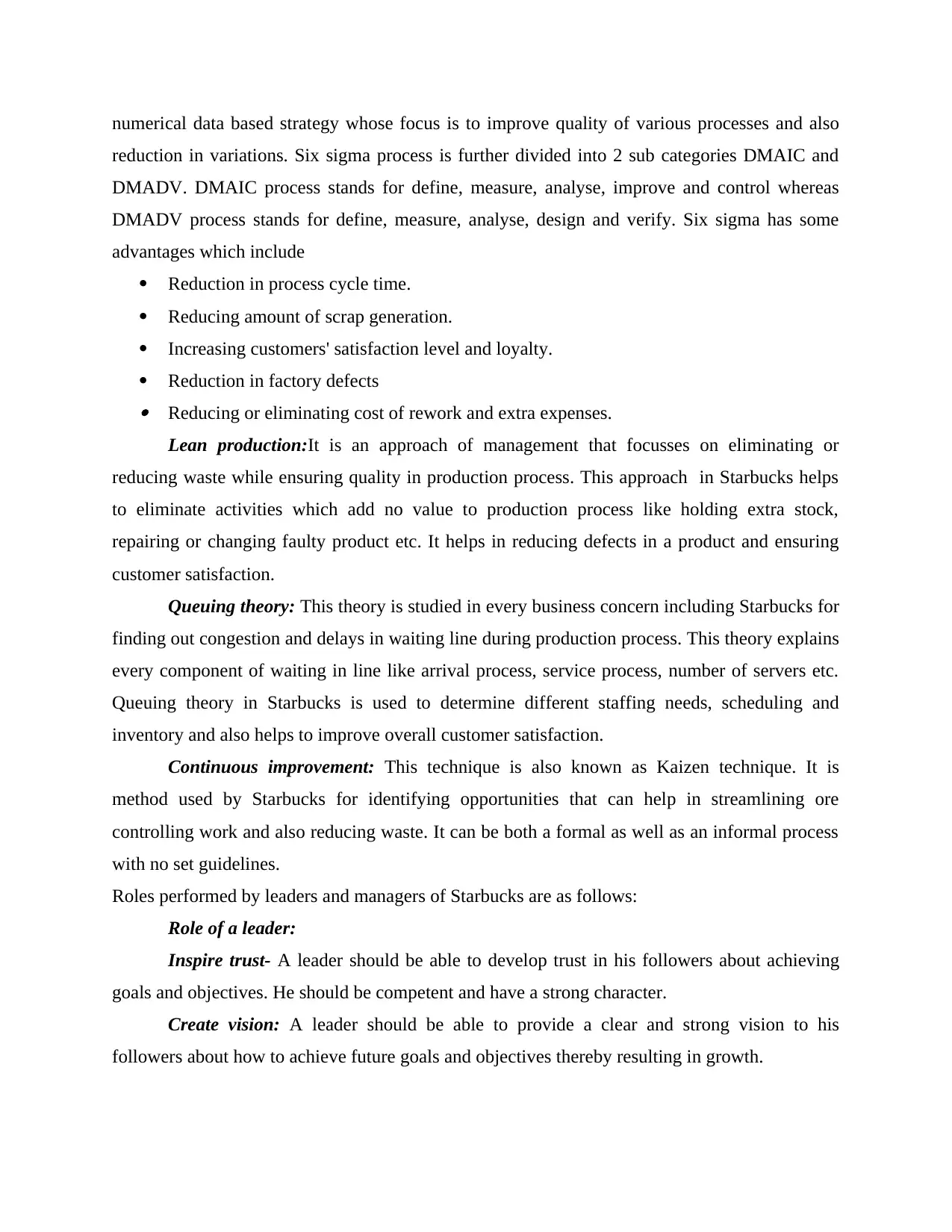
numerical data based strategy whose focus is to improve quality of various processes and also
reduction in variations. Six sigma process is further divided into 2 sub categories DMAIC and
DMADV. DMAIC process stands for define, measure, analyse, improve and control whereas
DMADV process stands for define, measure, analyse, design and verify. Six sigma has some
advantages which include
Reduction in process cycle time.
Reducing amount of scrap generation.
Increasing customers' satisfaction level and loyalty.
Reduction in factory defects Reducing or eliminating cost of rework and extra expenses.
Lean production:It is an approach of management that focusses on eliminating or
reducing waste while ensuring quality in production process. This approach in Starbucks helps
to eliminate activities which add no value to production process like holding extra stock,
repairing or changing faulty product etc. It helps in reducing defects in a product and ensuring
customer satisfaction.
Queuing theory: This theory is studied in every business concern including Starbucks for
finding out congestion and delays in waiting line during production process. This theory explains
every component of waiting in line like arrival process, service process, number of servers etc.
Queuing theory in Starbucks is used to determine different staffing needs, scheduling and
inventory and also helps to improve overall customer satisfaction.
Continuous improvement: This technique is also known as Kaizen technique. It is
method used by Starbucks for identifying opportunities that can help in streamlining ore
controlling work and also reducing waste. It can be both a formal as well as an informal process
with no set guidelines.
Roles performed by leaders and managers of Starbucks are as follows:
Role of a leader:
Inspire trust- A leader should be able to develop trust in his followers about achieving
goals and objectives. He should be competent and have a strong character.
Create vision: A leader should be able to provide a clear and strong vision to his
followers about how to achieve future goals and objectives thereby resulting in growth.
reduction in variations. Six sigma process is further divided into 2 sub categories DMAIC and
DMADV. DMAIC process stands for define, measure, analyse, improve and control whereas
DMADV process stands for define, measure, analyse, design and verify. Six sigma has some
advantages which include
Reduction in process cycle time.
Reducing amount of scrap generation.
Increasing customers' satisfaction level and loyalty.
Reduction in factory defects Reducing or eliminating cost of rework and extra expenses.
Lean production:It is an approach of management that focusses on eliminating or
reducing waste while ensuring quality in production process. This approach in Starbucks helps
to eliminate activities which add no value to production process like holding extra stock,
repairing or changing faulty product etc. It helps in reducing defects in a product and ensuring
customer satisfaction.
Queuing theory: This theory is studied in every business concern including Starbucks for
finding out congestion and delays in waiting line during production process. This theory explains
every component of waiting in line like arrival process, service process, number of servers etc.
Queuing theory in Starbucks is used to determine different staffing needs, scheduling and
inventory and also helps to improve overall customer satisfaction.
Continuous improvement: This technique is also known as Kaizen technique. It is
method used by Starbucks for identifying opportunities that can help in streamlining ore
controlling work and also reducing waste. It can be both a formal as well as an informal process
with no set guidelines.
Roles performed by leaders and managers of Starbucks are as follows:
Role of a leader:
Inspire trust- A leader should be able to develop trust in his followers about achieving
goals and objectives. He should be competent and have a strong character.
Create vision: A leader should be able to provide a clear and strong vision to his
followers about how to achieve future goals and objectives thereby resulting in growth.
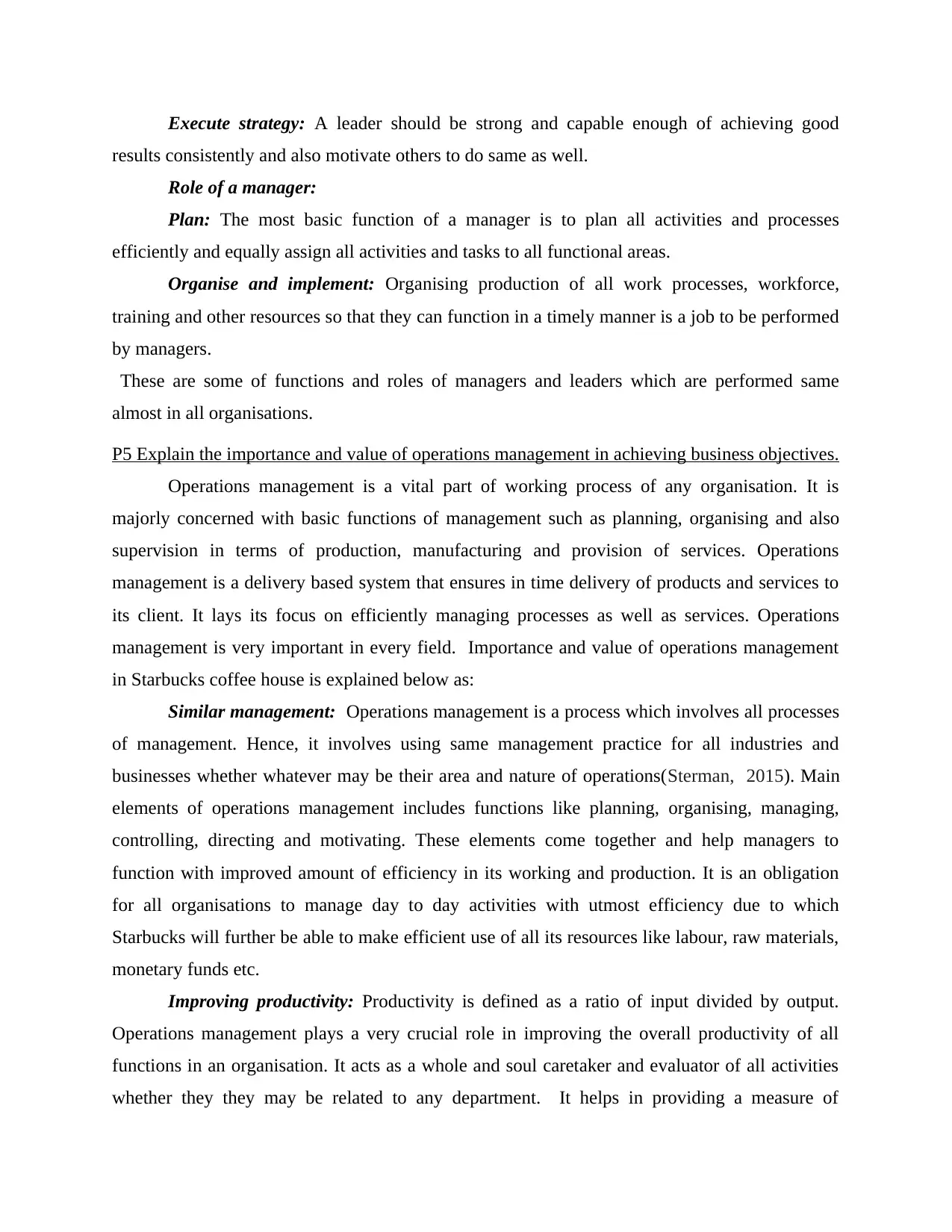
Execute strategy: A leader should be strong and capable enough of achieving good
results consistently and also motivate others to do same as well.
Role of a manager:
Plan: The most basic function of a manager is to plan all activities and processes
efficiently and equally assign all activities and tasks to all functional areas.
Organise and implement: Organising production of all work processes, workforce,
training and other resources so that they can function in a timely manner is a job to be performed
by managers.
These are some of functions and roles of managers and leaders which are performed same
almost in all organisations.
P5 Explain the importance and value of operations management in achieving business objectives.
Operations management is a vital part of working process of any organisation. It is
majorly concerned with basic functions of management such as planning, organising and also
supervision in terms of production, manufacturing and provision of services. Operations
management is a delivery based system that ensures in time delivery of products and services to
its client. It lays its focus on efficiently managing processes as well as services. Operations
management is very important in every field. Importance and value of operations management
in Starbucks coffee house is explained below as:
Similar management: Operations management is a process which involves all processes
of management. Hence, it involves using same management practice for all industries and
businesses whether whatever may be their area and nature of operations(Sterman, 2015). Main
elements of operations management includes functions like planning, organising, managing,
controlling, directing and motivating. These elements come together and help managers to
function with improved amount of efficiency in its working and production. It is an obligation
for all organisations to manage day to day activities with utmost efficiency due to which
Starbucks will further be able to make efficient use of all its resources like labour, raw materials,
monetary funds etc.
Improving productivity: Productivity is defined as a ratio of input divided by output.
Operations management plays a very crucial role in improving the overall productivity of all
functions in an organisation. It acts as a whole and soul caretaker and evaluator of all activities
whether they they may be related to any department. It helps in providing a measure of
results consistently and also motivate others to do same as well.
Role of a manager:
Plan: The most basic function of a manager is to plan all activities and processes
efficiently and equally assign all activities and tasks to all functional areas.
Organise and implement: Organising production of all work processes, workforce,
training and other resources so that they can function in a timely manner is a job to be performed
by managers.
These are some of functions and roles of managers and leaders which are performed same
almost in all organisations.
P5 Explain the importance and value of operations management in achieving business objectives.
Operations management is a vital part of working process of any organisation. It is
majorly concerned with basic functions of management such as planning, organising and also
supervision in terms of production, manufacturing and provision of services. Operations
management is a delivery based system that ensures in time delivery of products and services to
its client. It lays its focus on efficiently managing processes as well as services. Operations
management is very important in every field. Importance and value of operations management
in Starbucks coffee house is explained below as:
Similar management: Operations management is a process which involves all processes
of management. Hence, it involves using same management practice for all industries and
businesses whether whatever may be their area and nature of operations(Sterman, 2015). Main
elements of operations management includes functions like planning, organising, managing,
controlling, directing and motivating. These elements come together and help managers to
function with improved amount of efficiency in its working and production. It is an obligation
for all organisations to manage day to day activities with utmost efficiency due to which
Starbucks will further be able to make efficient use of all its resources like labour, raw materials,
monetary funds etc.
Improving productivity: Productivity is defined as a ratio of input divided by output.
Operations management plays a very crucial role in improving the overall productivity of all
functions in an organisation. It acts as a whole and soul caretaker and evaluator of all activities
whether they they may be related to any department. It helps in providing a measure of
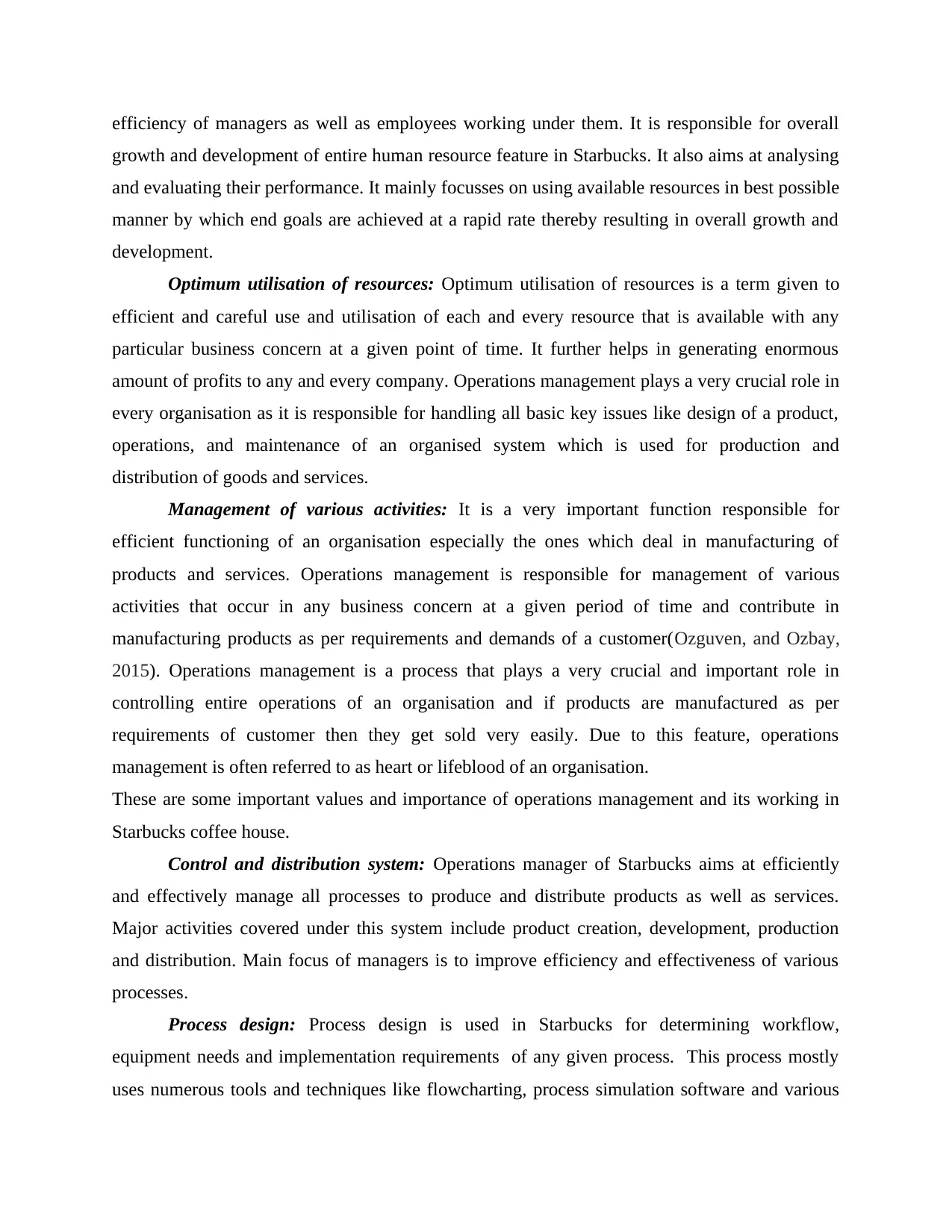
efficiency of managers as well as employees working under them. It is responsible for overall
growth and development of entire human resource feature in Starbucks. It also aims at analysing
and evaluating their performance. It mainly focusses on using available resources in best possible
manner by which end goals are achieved at a rapid rate thereby resulting in overall growth and
development.
Optimum utilisation of resources: Optimum utilisation of resources is a term given to
efficient and careful use and utilisation of each and every resource that is available with any
particular business concern at a given point of time. It further helps in generating enormous
amount of profits to any and every company. Operations management plays a very crucial role in
every organisation as it is responsible for handling all basic key issues like design of a product,
operations, and maintenance of an organised system which is used for production and
distribution of goods and services.
Management of various activities: It is a very important function responsible for
efficient functioning of an organisation especially the ones which deal in manufacturing of
products and services. Operations management is responsible for management of various
activities that occur in any business concern at a given period of time and contribute in
manufacturing products as per requirements and demands of a customer(Ozguven, and Ozbay,
2015). Operations management is a process that plays a very crucial and important role in
controlling entire operations of an organisation and if products are manufactured as per
requirements of customer then they get sold very easily. Due to this feature, operations
management is often referred to as heart or lifeblood of an organisation.
These are some important values and importance of operations management and its working in
Starbucks coffee house.
Control and distribution system: Operations manager of Starbucks aims at efficiently
and effectively manage all processes to produce and distribute products as well as services.
Major activities covered under this system include product creation, development, production
and distribution. Main focus of managers is to improve efficiency and effectiveness of various
processes.
Process design: Process design is used in Starbucks for determining workflow,
equipment needs and implementation requirements of any given process. This process mostly
uses numerous tools and techniques like flowcharting, process simulation software and various
growth and development of entire human resource feature in Starbucks. It also aims at analysing
and evaluating their performance. It mainly focusses on using available resources in best possible
manner by which end goals are achieved at a rapid rate thereby resulting in overall growth and
development.
Optimum utilisation of resources: Optimum utilisation of resources is a term given to
efficient and careful use and utilisation of each and every resource that is available with any
particular business concern at a given point of time. It further helps in generating enormous
amount of profits to any and every company. Operations management plays a very crucial role in
every organisation as it is responsible for handling all basic key issues like design of a product,
operations, and maintenance of an organised system which is used for production and
distribution of goods and services.
Management of various activities: It is a very important function responsible for
efficient functioning of an organisation especially the ones which deal in manufacturing of
products and services. Operations management is responsible for management of various
activities that occur in any business concern at a given period of time and contribute in
manufacturing products as per requirements and demands of a customer(Ozguven, and Ozbay,
2015). Operations management is a process that plays a very crucial and important role in
controlling entire operations of an organisation and if products are manufactured as per
requirements of customer then they get sold very easily. Due to this feature, operations
management is often referred to as heart or lifeblood of an organisation.
These are some important values and importance of operations management and its working in
Starbucks coffee house.
Control and distribution system: Operations manager of Starbucks aims at efficiently
and effectively manage all processes to produce and distribute products as well as services.
Major activities covered under this system include product creation, development, production
and distribution. Main focus of managers is to improve efficiency and effectiveness of various
processes.
Process design: Process design is used in Starbucks for determining workflow,
equipment needs and implementation requirements of any given process. This process mostly
uses numerous tools and techniques like flowcharting, process simulation software and various
Paraphrase This Document
Need a fresh take? Get an instant paraphrase of this document with our AI Paraphraser
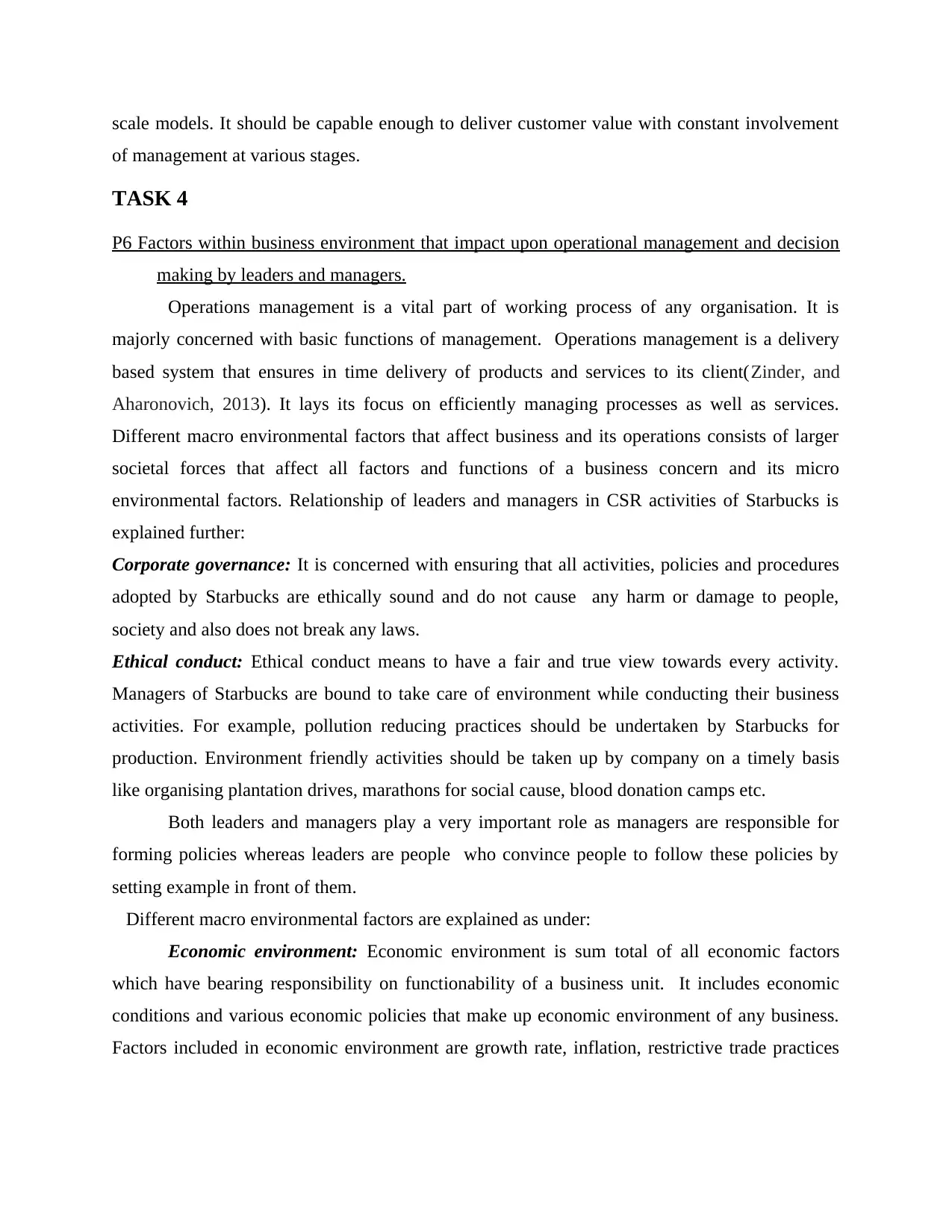
scale models. It should be capable enough to deliver customer value with constant involvement
of management at various stages.
TASK 4
P6 Factors within business environment that impact upon operational management and decision
making by leaders and managers.
Operations management is a vital part of working process of any organisation. It is
majorly concerned with basic functions of management. Operations management is a delivery
based system that ensures in time delivery of products and services to its client(Zinder, and
Aharonovich, 2013). It lays its focus on efficiently managing processes as well as services.
Different macro environmental factors that affect business and its operations consists of larger
societal forces that affect all factors and functions of a business concern and its micro
environmental factors. Relationship of leaders and managers in CSR activities of Starbucks is
explained further:
Corporate governance: It is concerned with ensuring that all activities, policies and procedures
adopted by Starbucks are ethically sound and do not cause any harm or damage to people,
society and also does not break any laws.
Ethical conduct: Ethical conduct means to have a fair and true view towards every activity.
Managers of Starbucks are bound to take care of environment while conducting their business
activities. For example, pollution reducing practices should be undertaken by Starbucks for
production. Environment friendly activities should be taken up by company on a timely basis
like organising plantation drives, marathons for social cause, blood donation camps etc.
Both leaders and managers play a very important role as managers are responsible for
forming policies whereas leaders are people who convince people to follow these policies by
setting example in front of them.
Different macro environmental factors are explained as under:
Economic environment: Economic environment is sum total of all economic factors
which have bearing responsibility on functionability of a business unit. It includes economic
conditions and various economic policies that make up economic environment of any business.
Factors included in economic environment are growth rate, inflation, restrictive trade practices
of management at various stages.
TASK 4
P6 Factors within business environment that impact upon operational management and decision
making by leaders and managers.
Operations management is a vital part of working process of any organisation. It is
majorly concerned with basic functions of management. Operations management is a delivery
based system that ensures in time delivery of products and services to its client(Zinder, and
Aharonovich, 2013). It lays its focus on efficiently managing processes as well as services.
Different macro environmental factors that affect business and its operations consists of larger
societal forces that affect all factors and functions of a business concern and its micro
environmental factors. Relationship of leaders and managers in CSR activities of Starbucks is
explained further:
Corporate governance: It is concerned with ensuring that all activities, policies and procedures
adopted by Starbucks are ethically sound and do not cause any harm or damage to people,
society and also does not break any laws.
Ethical conduct: Ethical conduct means to have a fair and true view towards every activity.
Managers of Starbucks are bound to take care of environment while conducting their business
activities. For example, pollution reducing practices should be undertaken by Starbucks for
production. Environment friendly activities should be taken up by company on a timely basis
like organising plantation drives, marathons for social cause, blood donation camps etc.
Both leaders and managers play a very important role as managers are responsible for
forming policies whereas leaders are people who convince people to follow these policies by
setting example in front of them.
Different macro environmental factors are explained as under:
Economic environment: Economic environment is sum total of all economic factors
which have bearing responsibility on functionability of a business unit. It includes economic
conditions and various economic policies that make up economic environment of any business.
Factors included in economic environment are growth rate, inflation, restrictive trade practices
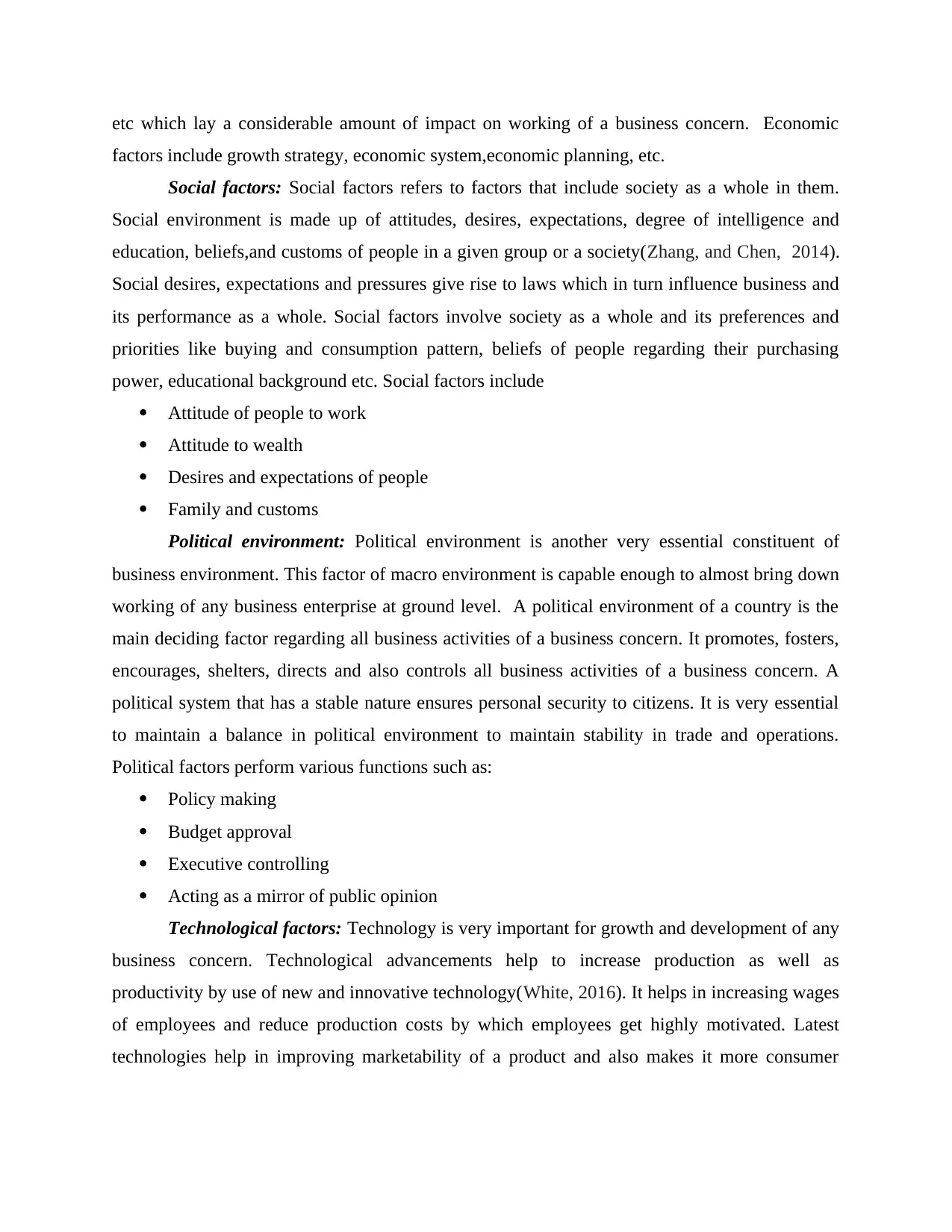
etc which lay a considerable amount of impact on working of a business concern. Economic
factors include growth strategy, economic system,economic planning, etc.
Social factors: Social factors refers to factors that include society as a whole in them.
Social environment is made up of attitudes, desires, expectations, degree of intelligence and
education, beliefs,and customs of people in a given group or a society(Zhang, and Chen, 2014).
Social desires, expectations and pressures give rise to laws which in turn influence business and
its performance as a whole. Social factors involve society as a whole and its preferences and
priorities like buying and consumption pattern, beliefs of people regarding their purchasing
power, educational background etc. Social factors include
Attitude of people to work
Attitude to wealth
Desires and expectations of people
Family and customs
Political environment: Political environment is another very essential constituent of
business environment. This factor of macro environment is capable enough to almost bring down
working of any business enterprise at ground level. A political environment of a country is the
main deciding factor regarding all business activities of a business concern. It promotes, fosters,
encourages, shelters, directs and also controls all business activities of a business concern. A
political system that has a stable nature ensures personal security to citizens. It is very essential
to maintain a balance in political environment to maintain stability in trade and operations.
Political factors perform various functions such as:
Policy making
Budget approval
Executive controlling
Acting as a mirror of public opinion
Technological factors: Technology is very important for growth and development of any
business concern. Technological advancements help to increase production as well as
productivity by use of new and innovative technology(White, 2016). It helps in increasing wages
of employees and reduce production costs by which employees get highly motivated. Latest
technologies help in improving marketability of a product and also makes it more consumer
factors include growth strategy, economic system,economic planning, etc.
Social factors: Social factors refers to factors that include society as a whole in them.
Social environment is made up of attitudes, desires, expectations, degree of intelligence and
education, beliefs,and customs of people in a given group or a society(Zhang, and Chen, 2014).
Social desires, expectations and pressures give rise to laws which in turn influence business and
its performance as a whole. Social factors involve society as a whole and its preferences and
priorities like buying and consumption pattern, beliefs of people regarding their purchasing
power, educational background etc. Social factors include
Attitude of people to work
Attitude to wealth
Desires and expectations of people
Family and customs
Political environment: Political environment is another very essential constituent of
business environment. This factor of macro environment is capable enough to almost bring down
working of any business enterprise at ground level. A political environment of a country is the
main deciding factor regarding all business activities of a business concern. It promotes, fosters,
encourages, shelters, directs and also controls all business activities of a business concern. A
political system that has a stable nature ensures personal security to citizens. It is very essential
to maintain a balance in political environment to maintain stability in trade and operations.
Political factors perform various functions such as:
Policy making
Budget approval
Executive controlling
Acting as a mirror of public opinion
Technological factors: Technology is very important for growth and development of any
business concern. Technological advancements help to increase production as well as
productivity by use of new and innovative technology(White, 2016). It helps in increasing wages
of employees and reduce production costs by which employees get highly motivated. Latest
technologies help in improving marketability of a product and also makes it more consumer

friendly. So to improve performance and productivity, it is very important for any business to
keep pace with changing technologies and helps to survive them in long run as well.
These are basic macro environmental factors which affect functioning of operations
management and decision making of leaders at Starbucks.
CONCLUSION
As per above mentioned project, it has been concluded that operations management plays
a very essential role in each and every management organisation to perform effectively and
efficiently. It is a function which involves planning, organising and directing of different
functions of management. According to this report, there are various roles and responsibilities
that are performed by managers and leaders to accomplish organisational benefits. Leaders and
managers can use different types of theories to perform their work in best possible manner. As
per this report, it have been analysed that just in time theory is best for the management function
of Starbucks. Also, there are some business factors which affect decision making have to be
taken care by management. Leaders and managers can implement soft skill to bring out best from
their employees. They can also use different types of approaches like total quality management
approach, just- in- time approach to make their management function more effectively and help
in overall growth and development.
keep pace with changing technologies and helps to survive them in long run as well.
These are basic macro environmental factors which affect functioning of operations
management and decision making of leaders at Starbucks.
CONCLUSION
As per above mentioned project, it has been concluded that operations management plays
a very essential role in each and every management organisation to perform effectively and
efficiently. It is a function which involves planning, organising and directing of different
functions of management. According to this report, there are various roles and responsibilities
that are performed by managers and leaders to accomplish organisational benefits. Leaders and
managers can use different types of theories to perform their work in best possible manner. As
per this report, it have been analysed that just in time theory is best for the management function
of Starbucks. Also, there are some business factors which affect decision making have to be
taken care by management. Leaders and managers can implement soft skill to bring out best from
their employees. They can also use different types of approaches like total quality management
approach, just- in- time approach to make their management function more effectively and help
in overall growth and development.
Secure Best Marks with AI Grader
Need help grading? Try our AI Grader for instant feedback on your assignments.
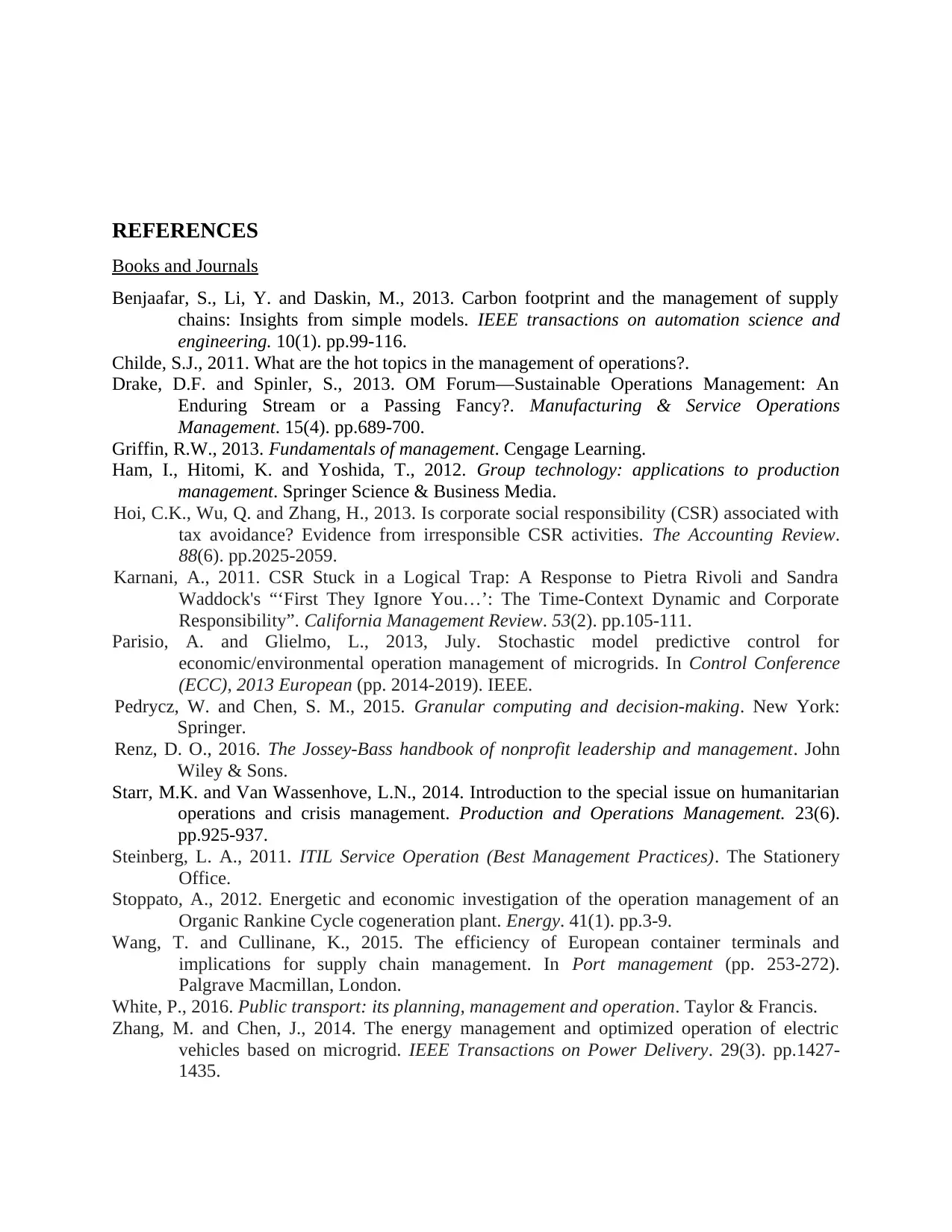
REFERENCES
Books and Journals
Benjaafar, S., Li, Y. and Daskin, M., 2013. Carbon footprint and the management of supply
chains: Insights from simple models. IEEE transactions on automation science and
engineering. 10(1). pp.99-116.
Childe, S.J., 2011. What are the hot topics in the management of operations?.
Drake, D.F. and Spinler, S., 2013. OM Forum—Sustainable Operations Management: An
Enduring Stream or a Passing Fancy?. Manufacturing & Service Operations
Management. 15(4). pp.689-700.
Griffin, R.W., 2013. Fundamentals of management. Cengage Learning.
Ham, I., Hitomi, K. and Yoshida, T., 2012. Group technology: applications to production
management. Springer Science & Business Media.
Hoi, C.K., Wu, Q. and Zhang, H., 2013. Is corporate social responsibility (CSR) associated with
tax avoidance? Evidence from irresponsible CSR activities. The Accounting Review.
88(6). pp.2025-2059.
Karnani, A., 2011. CSR Stuck in a Logical Trap: A Response to Pietra Rivoli and Sandra
Waddock's “‘First They Ignore You…’: The Time-Context Dynamic and Corporate
Responsibility”. California Management Review. 53(2). pp.105-111.
Parisio, A. and Glielmo, L., 2013, July. Stochastic model predictive control for
economic/environmental operation management of microgrids. In Control Conference
(ECC), 2013 European (pp. 2014-2019). IEEE.
Pedrycz, W. and Chen, S. M., 2015. Granular computing and decision-making. New York:
Springer.
Renz, D. O., 2016. The Jossey-Bass handbook of nonprofit leadership and management. John
Wiley & Sons.
Starr, M.K. and Van Wassenhove, L.N., 2014. Introduction to the special issue on humanitarian
operations and crisis management. Production and Operations Management. 23(6).
pp.925-937.
Steinberg, L. A., 2011. ITIL Service Operation (Best Management Practices). The Stationery
Office.
Stoppato, A., 2012. Energetic and economic investigation of the operation management of an
Organic Rankine Cycle cogeneration plant. Energy. 41(1). pp.3-9.
Wang, T. and Cullinane, K., 2015. The efficiency of European container terminals and
implications for supply chain management. In Port management (pp. 253-272).
Palgrave Macmillan, London.
White, P., 2016. Public transport: its planning, management and operation. Taylor & Francis.
Zhang, M. and Chen, J., 2014. The energy management and optimized operation of electric
vehicles based on microgrid. IEEE Transactions on Power Delivery. 29(3). pp.1427-
1435.
Books and Journals
Benjaafar, S., Li, Y. and Daskin, M., 2013. Carbon footprint and the management of supply
chains: Insights from simple models. IEEE transactions on automation science and
engineering. 10(1). pp.99-116.
Childe, S.J., 2011. What are the hot topics in the management of operations?.
Drake, D.F. and Spinler, S., 2013. OM Forum—Sustainable Operations Management: An
Enduring Stream or a Passing Fancy?. Manufacturing & Service Operations
Management. 15(4). pp.689-700.
Griffin, R.W., 2013. Fundamentals of management. Cengage Learning.
Ham, I., Hitomi, K. and Yoshida, T., 2012. Group technology: applications to production
management. Springer Science & Business Media.
Hoi, C.K., Wu, Q. and Zhang, H., 2013. Is corporate social responsibility (CSR) associated with
tax avoidance? Evidence from irresponsible CSR activities. The Accounting Review.
88(6). pp.2025-2059.
Karnani, A., 2011. CSR Stuck in a Logical Trap: A Response to Pietra Rivoli and Sandra
Waddock's “‘First They Ignore You…’: The Time-Context Dynamic and Corporate
Responsibility”. California Management Review. 53(2). pp.105-111.
Parisio, A. and Glielmo, L., 2013, July. Stochastic model predictive control for
economic/environmental operation management of microgrids. In Control Conference
(ECC), 2013 European (pp. 2014-2019). IEEE.
Pedrycz, W. and Chen, S. M., 2015. Granular computing and decision-making. New York:
Springer.
Renz, D. O., 2016. The Jossey-Bass handbook of nonprofit leadership and management. John
Wiley & Sons.
Starr, M.K. and Van Wassenhove, L.N., 2014. Introduction to the special issue on humanitarian
operations and crisis management. Production and Operations Management. 23(6).
pp.925-937.
Steinberg, L. A., 2011. ITIL Service Operation (Best Management Practices). The Stationery
Office.
Stoppato, A., 2012. Energetic and economic investigation of the operation management of an
Organic Rankine Cycle cogeneration plant. Energy. 41(1). pp.3-9.
Wang, T. and Cullinane, K., 2015. The efficiency of European container terminals and
implications for supply chain management. In Port management (pp. 253-272).
Palgrave Macmillan, London.
White, P., 2016. Public transport: its planning, management and operation. Taylor & Francis.
Zhang, M. and Chen, J., 2014. The energy management and optimized operation of electric
vehicles based on microgrid. IEEE Transactions on Power Delivery. 29(3). pp.1427-
1435.
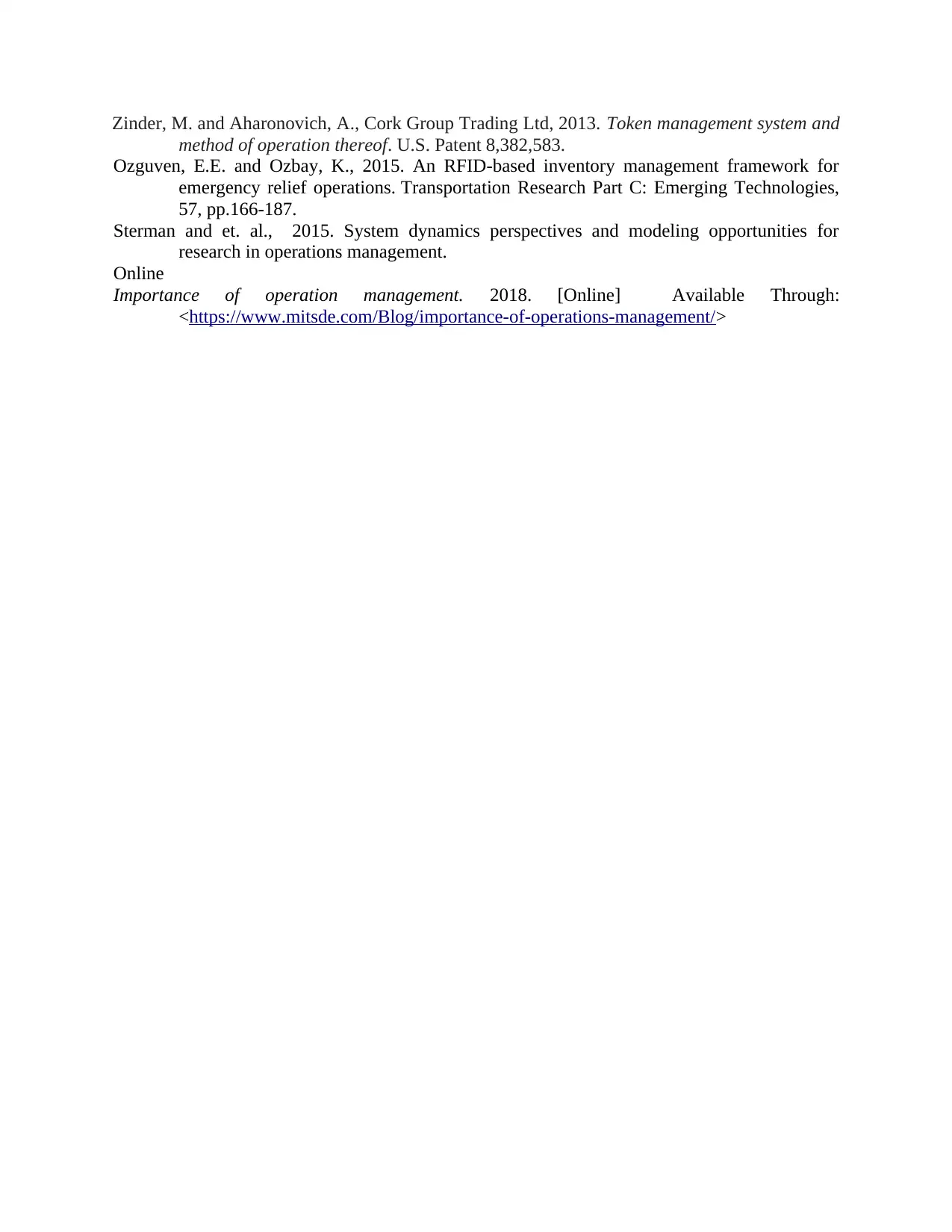
Zinder, M. and Aharonovich, A., Cork Group Trading Ltd, 2013. Token management system and
method of operation thereof. U.S. Patent 8,382,583.
Ozguven, E.E. and Ozbay, K., 2015. An RFID-based inventory management framework for
emergency relief operations. Transportation Research Part C: Emerging Technologies,
57, pp.166-187.
Sterman and et. al., 2015. System dynamics perspectives and modeling opportunities for
research in operations management.
Online
Importance of operation management. 2018. [Online] Available Through:
<https://www.mitsde.com/Blog/importance-of-operations-management/>
method of operation thereof. U.S. Patent 8,382,583.
Ozguven, E.E. and Ozbay, K., 2015. An RFID-based inventory management framework for
emergency relief operations. Transportation Research Part C: Emerging Technologies,
57, pp.166-187.
Sterman and et. al., 2015. System dynamics perspectives and modeling opportunities for
research in operations management.
Online
Importance of operation management. 2018. [Online] Available Through:
<https://www.mitsde.com/Blog/importance-of-operations-management/>
1 out of 18
Your All-in-One AI-Powered Toolkit for Academic Success.
+13062052269
info@desklib.com
Available 24*7 on WhatsApp / Email
![[object Object]](/_next/static/media/star-bottom.7253800d.svg)
Unlock your academic potential
© 2024 | Zucol Services PVT LTD | All rights reserved.





